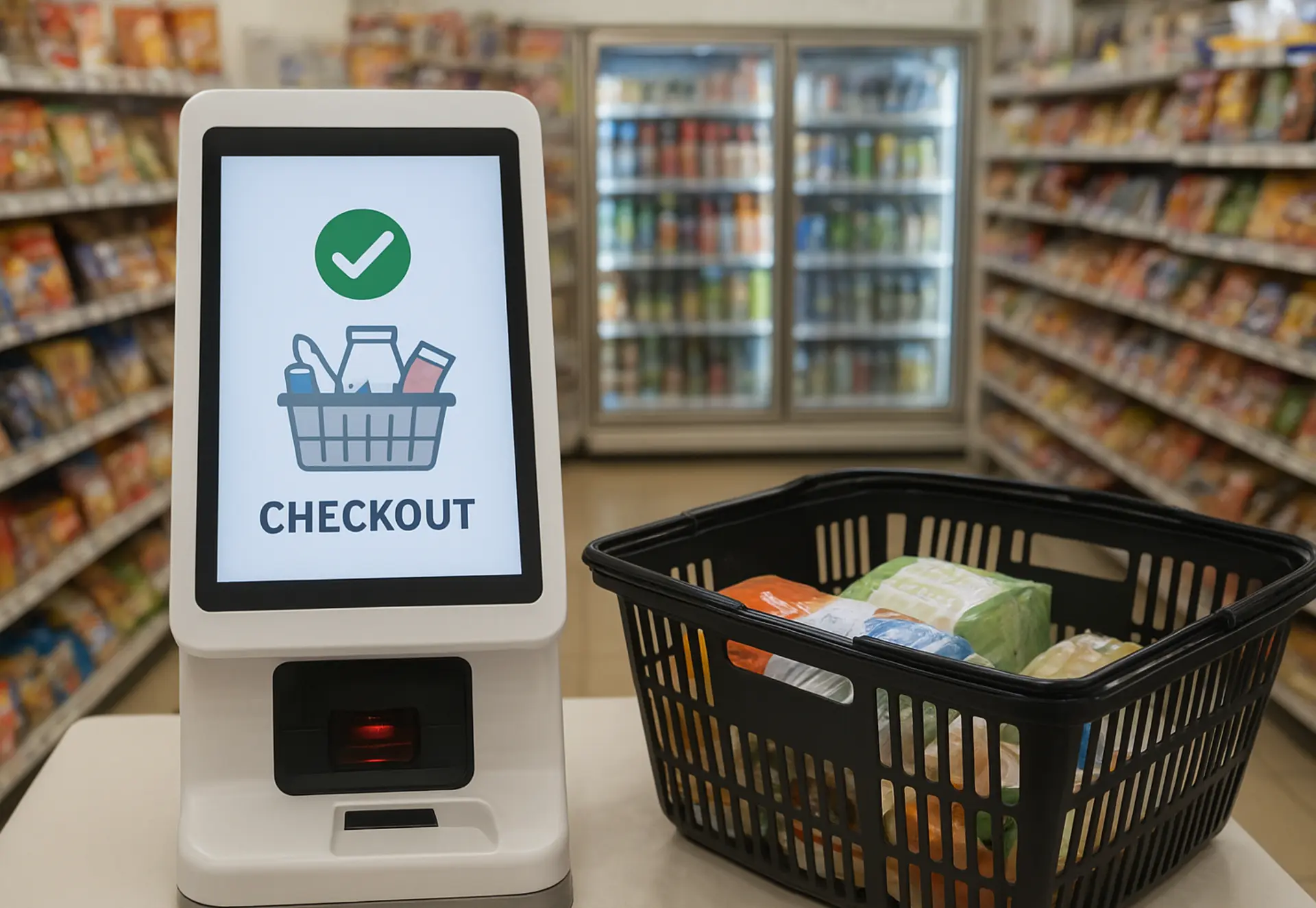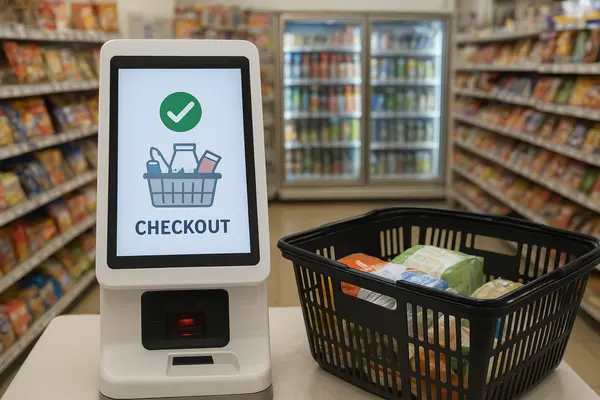
RFID in Japan’s Convenience Stores
Big Dreams, Real-World Limits
As Japan grapples with a shrinking population and chronic labor shortages, automation has become the retail industry’s go-to solution. RFID (Radio-Frequency Identification) was once hailed as the technology that could revolutionize convenience store checkout — promising to “scan the entire shopping basket at once” and eliminate the need to scan items one by one.
Yet between early trials and nationwide rollout, RFID in convenience store checkout has run into multiple real-world obstacles. This article looks at Japan’s journey — from Lawson’s pilot project with Panasonic, to government-backed RFID initiatives, the reasons behind their limited adoption, and where RFID has actually found success in Japan.
The Beginning: Lawson × Panasonic’s “Regi-Robo” Experiment
In early 2017, Lawson and Panasonic unveiled Regi-Robo, a self-checkout prototype at an experimental Lawson store in Osaka. The demo showed how shoppers could simply place their basket on a device that instantly identified all items and processed payment.
The goal was to cut down checkout and bagging time, streamlining the process for customers. Regi-Robo was seen as a conceptual showcase combining RFID, automated bagging, and self-payment — but it remained a pilot project, never scaled to commercial deployment 1.
Related Article: Unseen Connections: The Origins and Evolution of RFID Technology
Government Ambition: A 2025 Vision for Full RFID Adoption
In 2019, Japan’s Ministry of Economy, Trade and Industry (METI) partnered with the country’s top five convenience store chains on an ambitious plan to boost automation through RFID and similar technologies.
Their goal? To equip nearly all stores — including 7-Eleven, Lawson, and FamilyMart — with RFID by 2025. The government pledged to support the industry by lowering tag costs, addressing material limitations (such as tags that can withstand microwave heating), and funding pilot programs 2. The plan drew international attention for its bold scope.
However, public reports indicate that despite subsidies and proof-of-concept trials, progress slowed considerably. Moving from pilot tests to full-scale deployment — with every single product RFID-tagged — proved far more difficult than expected.
Why RFID Struggled in Convenience Store Checkout
A. Tag Cost and Disposal (Economic and Environmental Issues)
Each tag placed on every item becomes a one-time cost — and since customers typically discard packaging after purchase, those tags go straight to the trash.
Even as tag prices fell, applying them to every low-margin, low-priced item in a convenience store remained uneconomical. While companies like DNP and Avery Dennison have continued developing cheaper tags, overhauling the entire supply chain takes time and investment 2, 3.
B. Added Workload in Labeling (Operational Bottlenecks)
Applying RFID tags to every product introduces an extra step in production or logistics. Manual tagging slows down operations and risks inconsistency; shifting the task to manufacturers requires changes to their production lines.
For stores selling thousands of small, inexpensive, fast-moving items — as convenience stores do — that extra labor simply doesn’t pay off 4.
C. Reading Accuracy and Material Interference
In “basket-level” reading scenarios, multiple RFID tags placed close together can block or interfere with one another. Certain packaging materials — aluminum foil, metals, or liquids — can weaken radio signals, leading to missed or incorrect reads 4.
These technical reliability issues make achieving “100% accurate reads” in real-world stores very challenging, affecting both trust and user experience.
D. Unpackaged and Freshly Made Foods/Pastries: Limited Applicability
Convenience stores sell a large number of ready-to-eat and freshly prepared items — from sandwiches to baked goods. Many of these products have little or no packaging, making it difficult or impractical to attach RFID tags. In addition, items that require heating, chilling, or rapid turnover further limit RFID’s durability and usability.
These challenges have slowed progress toward the government’s initial vision of full RFID adoption across Japan’s convenience store sector by 2025.
Where RFID Found Success: Apparel and Conveyor-Belt Sushi
While convenience stores struggled, other industries in Japan have embraced RFID. Two standouts are apparel retail and conveyor-belt sushi restaurants.
1) Apparel Retail: Smarter Inventory and Self-Checkout
In fashion retail, each item has a higher unit value and more variations — size, color, model — making precise inventory management critical.
Fast Retailing, the parent company of UNIQLO, began integrating RFID across its global supply chain in 2017. Every product can be tracked from production to sale, enabling real-time inventory visibility and faster restocking.
RFID also powers UNIQLO’s self-checkout counters, where shoppers simply place items in a tray and the system instantly identifies them all. The technology has significantly improved customer experience and operational efficiency — a perfect fit for an industry where cost and benefit align.
2) Conveyor-Belt Sushi: Freshness Tracking and Plate Counting
In conveyor-belt sushi restaurants, some chains embed RFID chips into the plates themselves. Each plate can then be tracked as it circulates, allowing the system to monitor how long sushi has been on the belt and automatically remove it after a set time to maintain freshness and safety.
RFID is also used to count the number and type of plates at the end of a meal, streamlining checkout. Chains like Sushiro have leveraged such systems to improve food management and even forecast demand 5.
However, adoption isn’t universal. RFID-embedded plates must withstand frequent washing and can’t be easily replaced, leading to higher customization and maintenance costs.
When RFID Falls Short, AI Steps In
For products that can’t be pre-tagged — like pastries, hot or deli foods, or other low-cost packaged goods — AI image recognition offers a more flexible alternative.
AI-based checkout systems can identify items visually, without the need for tags. One early example came from Viscovery in 2019, whose AI system could instantly recognize baked goods and send the full list of items to the POS system for fast checkout.
Thanks to advances in deep learning, such systems have become even more accurate and user-friendly in recent years, making AI vision a practical complement — or even a replacement — for RFID in bakeries, canteens, and convenience stores.
In short: Japan’s RFID ambitions in convenience store checkout have cooled from grand vision to cautious pragmatism. While the dream of fully automated “basket-level” scanning remains elusive, RFID continues to thrive in industries where its cost, durability, and efficiency advantages align — and where AI is now stepping in to fill the gaps.
Related Articles:
- Department Store Micromarket Innovates with AI Self-Checkout
- A Japan delicatessen, THE BAKE STORE, enables AI Recognition on its iPad POS system
- The Rise of Self-Service Dining in Japan: From Meal Ticket Machines to RFID and AI-Powered Checkout
- “Zero-Wait” Checkout in Japanese Corporate Cafeterias: From RFID to AI Vision Recognition

[References]
1 “The Industry-first Experimental Demonstration of “Regi-Robo(TM)”, an Entirely Automated Robotic Checkout System and RFIDs (Electronic Tags) at Lawson Panasonic-Mae Store.” Panasonic Newsroom Global. https://news.panasonic.com/global/topics/5090.
2 “Japan Aims To Automate All Convenience Stores By 2025 With A New RFID Technology.” Forbes. https://www.forbes.com/sites/akikokatayama/2019/02/26/japan-aims-to-automate-all-convenience-stores-by-2025-with-a-new-rfid-technology/.
3 “DNP Embarks Upon Development of Low Cost RFID Tag for Convenience Stores.” Dai Nippon Printing. https://www.global.dnp/news/detail/20166790_4126.html.
4 “100 BILLION RFID PROJECT IN JAPANESE RETAILING INDUSTRY.” Ministry of Economy, Trade and Industry (METI) Government of Japan. https://rainrfid.org/wp-content/uploads/2017/11/Japanese-RFID-Project.pdf.
5 “Trains on different tracks for top two Japanese conveyor-belt sushi chains.” SeafoodSource. https://www.seafoodsource.com/features/trains-on-different-tracks-for-top-two-japanese-conveyor-belt-sushi-chains.

